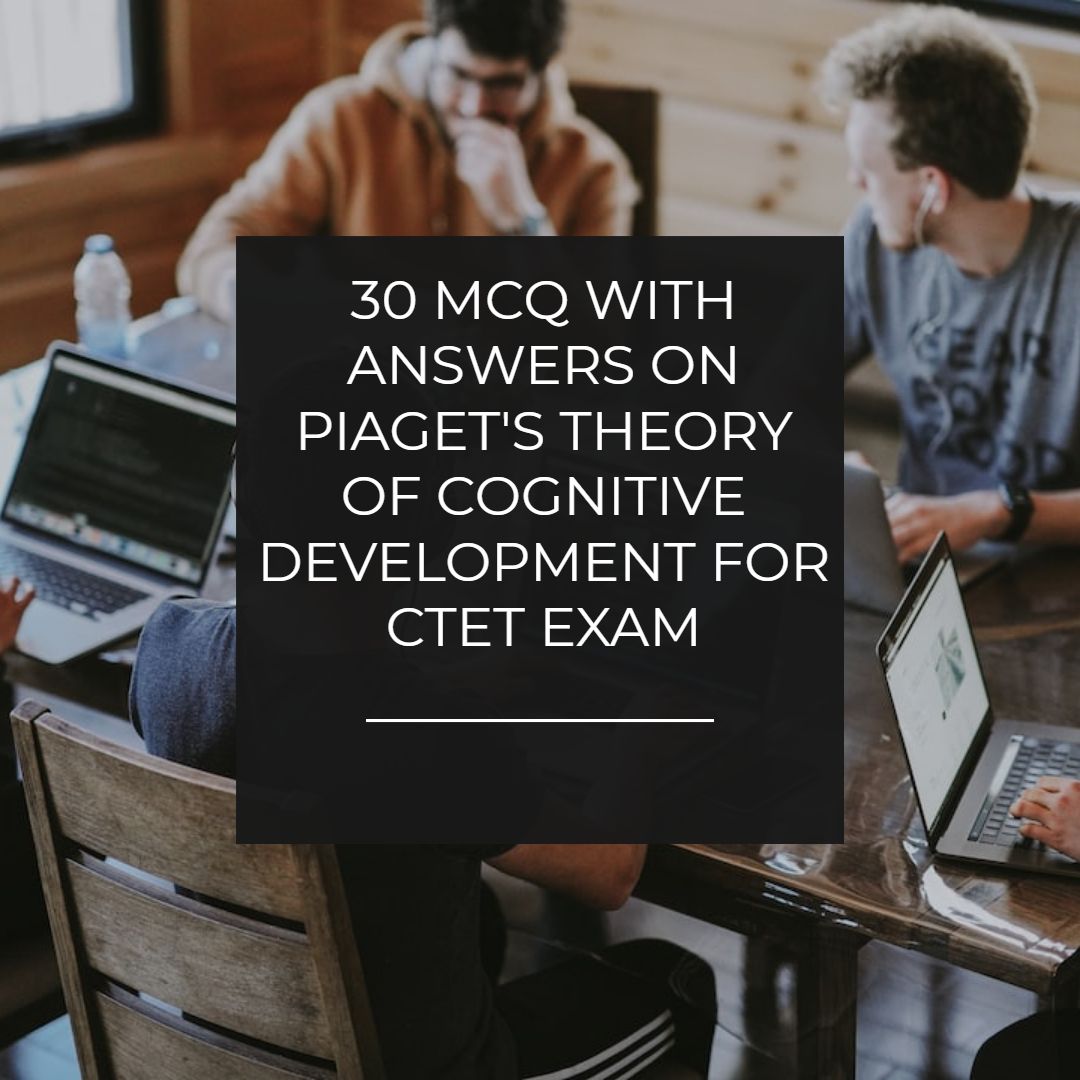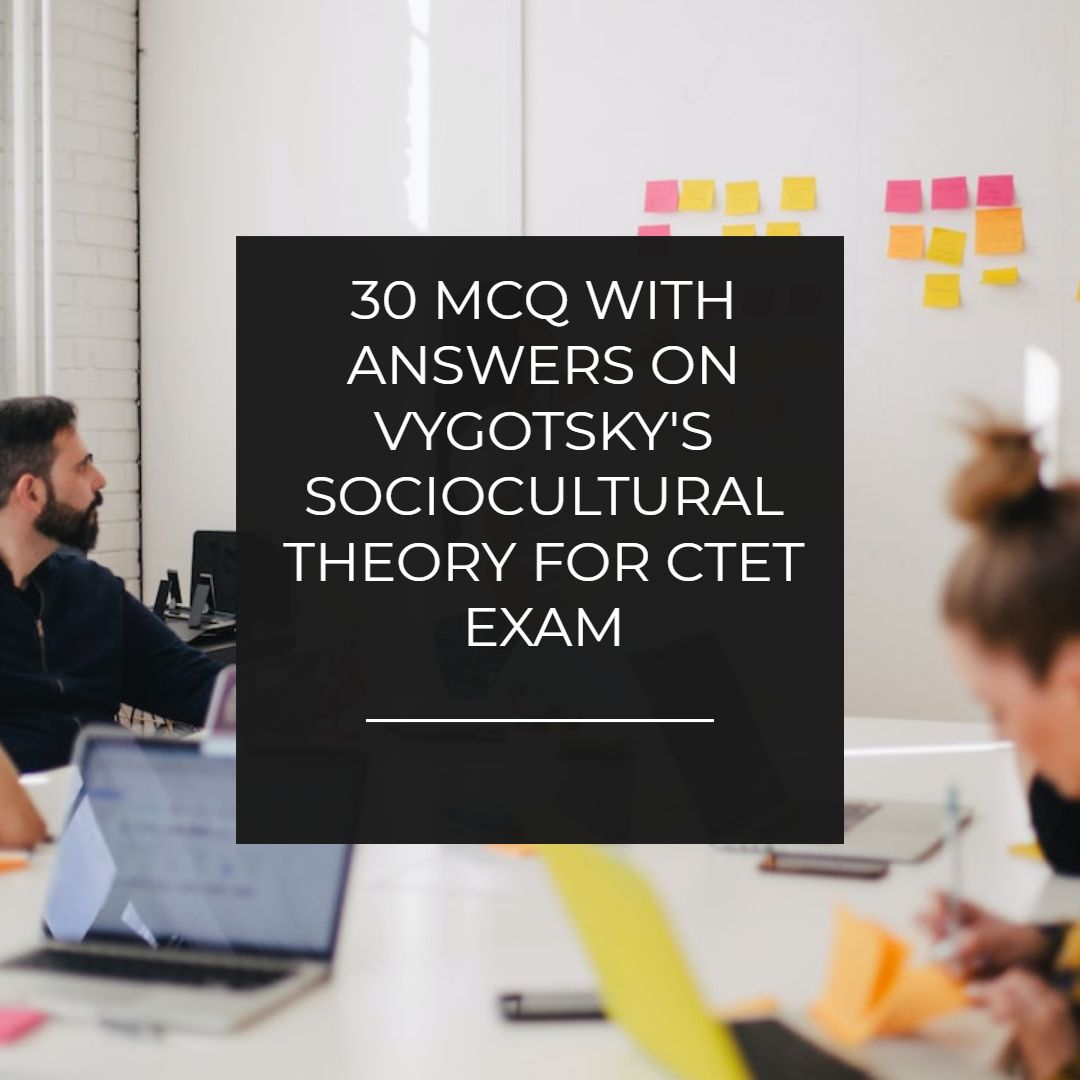30 MCQ with answers on Piaget's Theory of Cognitive Development for CTET exam
30 MCQ with answers on Piaget’s Theory of Cognitive Development for CTET exam
Piaget’s Theory of Cognitive Development
Piaget’s theory explains how children actively construct their knowledge through assimilation and accommodation. It consists of four stages: sensorimotor, preoperational, concrete operational, and formal operational. Understanding these stages will help teachers tailor their instructional strategies to match the cognitive abilities of their students.

- 30 MCQ With Answers on social and emotional Development For CTET Exam
- 30 MCQ With Answers on Cognitive Development For CTET Exam
- 30 MCQ With Answers on Physical Development for CTET exam
- 30 MCQ With Answers on Child Development and Pedagogy for CTET Exam
Here are 30 multiple-choice questions with answers on Piaget’s Theory of Cognitive Development for the CTET exam:
Piaget’s theory of cognitive development focuses on:
a) Physical development in children
b) Social development in children
c) Moral development in children
d) Intellectual development in children
Answer: d) Intellectual development in children
According to Piaget, cognitive development occurs through the process of:
a) Imitation
b) Conditioning
c) Maturation
d) Assimilation and accommodation
Answer: d) Assimilation and accommodation
Piaget identified four stages of cognitive development. Which stage occurs from birth to approximately 2 years of age?
a) Sensorimotor stage
b) Preoperational stage
c) Concrete operational stage
d) Formal operational stage
Answer: a) Sensorimotor stage
In the sensorimotor stage, children primarily learn about the world through:
a) Abstract reasoning
b) Concrete operations
c) Symbolic representation
d) Sensory experiences and motor actions
Answer: d) Sensory experiences and motor actions
Object permanence, the understanding that objects continue to exist even when out of sight, is a key achievement in which stage of Piaget’s theory?
a) Sensorimotor stage
b) Preoperational stage
c) Concrete operational stage
d) Formal operational stage
Answer: a) Sensorimotor stage
The preoperational stage, which occurs from approximately 2 to 7 years of age, is characterized by:
a) Egocentrism and animism
b) Logical and abstract reasoning
c) Conservation and reversibility
d) Hypothetical-deductive reasoning
Answer: a) Egocentrism and animism
Conservation refers to the understanding that:
a) Objects remain the same despite changes in appearance
b) Objects can be sorted into categories based on their properties
c) One object can be transformed into another through a series of actions
d) The total quantity of a substance remains the same despite changes in shape or arrangement
Answer: d) The total quantity of a substance remains the same despite changes in shape or arrangement
According to Piaget, the inability to take another person’s perspective is known as:
a) Egocentrism
b) Animism
c) Reversibility
d) Object permanence
Answer: a) Egocentrism
The concrete operational stage, which occurs from approximately 7 to 11 years of age, is characterized by the development of:
a) Abstract reasoning and hypothetical thinking
b) Formal operational thought
c) Conservation and logical thinking
d) Sensorimotor coordination and symbolic representation
Answer: c) Conservation and logical thinking
The formal operational stage, which begins around 11 years of age, is characterized by the ability to:
a) Think in concrete and tangible terms
b) Reason abstractly and think hypothetically
c) Understand conservation and reversibility
d) Engage in symbolic play and imaginative thinking
Answer: b) Reason abstractly and think hypothetically
According to Piaget, the process of incorporating new information into existing mental structures is called:
a) Accommodation
b) Assimilation
c) Equilibration
d) Conservation
Answer: b) Assimilation
The process of modifying existing mental structures to accommodate new information is called:
a) Accommodation
b) Assimilation
c) Equilibration
d) Conservation
Answer: a) Accommodation
Piaget believed that cognitive development is driven by a process of achieving a balance between existing knowledge and new experiences called:
a) Accommodation
b) Assimilation
c) Equilibration
d) Conservation
Answer: c) Equilibration
According to Piaget, when children encounter new information that does not fit with their existing knowledge, they experience a state of:
a) Assimilation
b) Accommodation
c) Equilibration
d) Conservation
Answer: b) Accommodation
The ability to understand that changing the appearance of an object does not change its fundamental properties is known as:
a) Object permanence
b) Conservation
c) Reversibility
d) Egocentrism
Answer: b) Conservation
Which of the following is a criticism of Piaget’s theory?
a) It underestimates the role of social interaction in cognitive development
b) It overemphasizes the importance of formal operational thinking
c) It lacks empirical evidence and relies too heavily on Piaget’s observations
d) It does not adequately address the role of genetics in cognitive development
Answer: a) It underestimates the role of social interaction in cognitive development
According to Piaget, which of the following is an example of a schema?
a) A mental representation of a dog
b) A collection of toys in a playroom
c) A set of rules for a board game
d) A sequence of motor actions for riding a bike
Answer: a) A mental representation of a dog
The term “object permanence” refers to the understanding that:
a) Objects exist even when they are out of sight
b) Objects can be transformed into different shapes and sizes
c) Objects can be sorted into categories based on their properties
d) Objects can be classified based on their size and weight
Answer: a) Objects exist even when they are out of sight
According to Piaget, which stage is characterized by the ability to think logically and solve concrete problems?
a) Sensorimotor stage
b) Preoperational stage
c) Concrete operational stage
d) Formal operational stage
Answer: c) Concrete operational stage
Which of the following is an example of centration?
a) Focusing on multiple aspects of a problem simultaneously
b) Understanding that the quantity of a substance remains the same despite changes in appearance
c) Recognizing that objects can be classified into different categories based on their properties
d) Paying attention only to the height of a container and ignoring its width when comparing quantities
Answer: d) Paying attention only to the height of a container and ignoring its width when comparing quantities
Which stage of Piaget’s theory is associated with the development of conservation and logical thinking?
a) Sensorimotor stage
b) Preoperational stage
c) Concrete operational stage
d) Formal operational stage
Answer: c) Concrete operational stage
In the preoperational stage, children’s thinking is characterized by:
a) Conservation and logical reasoning
b) Abstract and hypothetical thinking
c) Egocentrism and lack of conservation
d) Concrete operational thinking
Answer: c) Egocentrism and lack of conservation
Which of the following is a limitation of Piaget’s theory of cognitive development?
a) It does not account for individual differences in cognitive development
b) It does not address the role of social and cultural factors in cognitive development
c) It does not provide a clear framework for understanding cognitive development in adulthood
d) It does not consider the impact of genetics on cognitive development
Answer: b) It does not address the role of social and cultural factors in cognitive development
The process of mental representation and symbolic thinking in the preoperational stage is characterized by the use of:
a) Language and pretend play
b) Logical operations and abstract thinking
c) Sensorimotor coordination and motor actions
d) Egocentric thinking and animism
Answer: a) Language and pretend play
Which of the following best describes the concept of egocentrism in Piaget’s theory?
a) The ability to take another person’s perspective
b) The inability to understand conservation tasks
c) The belief that everyone thinks and perceives the world as oneself does
d) The capacity for abstract and hypothetical thinking
Answer: c) The belief that everyone thinks and perceives the world as oneself does
According to Piaget, which stage is characterized by the development of abstract and hypothetical thinking?
a) Sensorimotor stage
b) Preoperational stage
c) Concrete operational stage
d) Formal operational stage
Answer: d) Formal operational stage
The ability to mentally reverse an action and understand that it can be undone is known as:
a) Egocentrism
b) Animism
c) Reversibility
d) Object permanence
Answer: c) Reversibility
Which of the following best describes the concept of assimilation in Piaget’s theory?
a) The process of modifying existing mental structures to accommodate new information
b) The process of incorporating new information into existing mental structures
c) The process of achieving a balance between existing knowledge and new experiences
d) The process of achieving conservation and logical thinking
Answer: b) The process of incorporating new information into existing mental structures
According to Piaget, cognitive development is influenced by:
a) Social interactions and cultural experiences
b) Genetic factors and biological maturation
c) Formal education and academic instruction
d) Emotional and moral development
Answer: b) Genetic factors and biological maturation
Which of the following is a key concept in Piaget’s theory of cognitive development?
a) Social referencing
b) Self-regulation
c) Object permanence
d) Emotional intelligence
Answer: c) Object permanence
I hope these questions and answers on Piaget’s Theory of Cognitive Development will be helpful for your CTET exam preparation!




